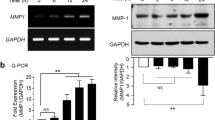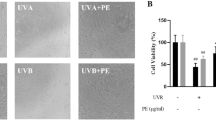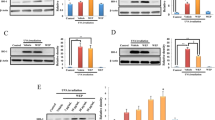Abstract
Backgrounds
The bark of Prunus yedoensis (PY) is used in herbal remedies for the treatment of inflammatory skin disorders. Previous studies have reported the antioxidative, anti-inflammatory, anticancer, and vasorelaxant effects of PY; however, the safety and toxicity of PY extracts have not yet been reported. In the present study, we explored whether PY bark extract induced toxicity in HaCaT, a human keratinocyte cell line.
Methods
HaCaT cells were treated with PYE, the ethyl acetate (EtOAc) fraction of the crude extract (produced from 80% EtOH) of PY, for 24 h and cytotoxicity and ROS generation were determined. In addition, we evaluated the effect of a high concentration of PYE on the transcriptional profile to determine the action mechanism of the toxicity to HaCaT cells.
Results
PYE treatment significantly induced cytotoxicity in HaCaT cells in a dose-dependent manner. At 313 μg/mL, PYE generated intracellular ROS and up-regulated immediate early genes and oxidative stress-related genes, indicating the activation of stress signals by PYE. Moreover, PYE significantly changed the expression of genes that promote ECM degradation, inflammatory responses, and keratinocyte differentiation.
Conclusion
The present study demonstrated that PYE at 313 μg/mL, a concentration which is not cytotoxic but generates intracellular ROS, affected gene regulation in HaCaT human keratinocytes through multiple toxicity mechanisms and could therefore disturb skin homeostasis or lead to skin aging. We propose that for the safe use of PYE in herbal cosmetic or medicines, further evaluations of the toxicity and safety in the skin must be performed.
Similar content being viewed by others
References
Lee, K. et al. Vasorelaxant effect of Prunus yedoensis bark. BMC Complement Altern Med 13, 31 (2013).
Jung, H. A., Kim, A. R., Chung, H. Y. & Choi, J. S. In vitro antioxidant activity of some selected Prunus species in Korea. Arch Pharm Res 25, 865–872 (2002).
Lee, J. et al. Anti-inflammatory effect of Prunus yedoensis through inhibition of nuclear factor kappa B in macrophages. BMC Complement Altern Med 13, 92 (2013).
Jung, H. A., Chung, H. Y., Jung, J. H. & Choi, J. S. A new pentacyclic triterpenoid glucoside fro. Prunus serrulata var. spontanea. Chem Pharm Bull 52, 157–159 (2004).
Lee, J. H. et al. Wound Healing Effects of Prunus yedoensis Matsumura Bark in Scalded Rats. Evid Based Complement Alternat Med 2017 doi: 10.1155/2017/7812598 (2017).
Li, L. et al. Antiphotoaging Effect of Prunus yedoensis Blossom Extract via Inhibition of MAPK/AP-1 and Regulation of the TGF-βI/Smad and Nrf2/ARESignaling Pathways. Photochem Photobiol doi: 10.1111/php.12894 (2018).
Park, J. W., Yuk, H. G. & Lee, S. C. Antioxidant and tyrosinase inhibitory activities of different parts of oriental cherry (Prunus serrulata var. spontanea). Food Sci Biotechnol 21, 339–343 (2012).
Matsuoka, N. et al. Study of the chemical constituents of Pruni Cortex and its related parts. J Nat Med 65, 166–171 (2011).
Seo, D. Y., Jin, M., Ryu, J. C. & Kim, Y. J. Investigation of the genetic toxicity by dextran-coated superparamagnetic iron oxide nanoparticles (SPION) in HepG2 cells using the comet assay and cytokinesisblock micronucleus assay. Toxicol Environ Health Sci 9, 23–29 (2017).
Taguchi, N. et al. Antioxidative effects of cherry leaves extract on tert-butyl hydroperoxide-mediated cytotoxicity through regulation of thioredoxin-2 protein expression levels. J Toxicol Environ Health A 74, 1240–1247 (2011).
Hwang, E. et al. Gallic acid regulates skin photoaging in UVB-exposed fibroblast and hairless mice. Phytother Res 28, 1778–1788 (2014).
Wertz, K. et al. β-carotene inhibits UVA-induced MMP1 and 10 expression in keratinocytes by a singlet oxygen-dependent mechanism. Free Radic Biol Med 37, 654–670 (2004).
Quan, T. et al. Elevated Cysteine-Rich 61 Mediates Aberrant Collagen Homeostasis in Chronologically Aged and Photoaged Human Skin. Am J Pathol 169, 482–490 (2006).
Aggarwal, B. B. & Shishodia, S. Molecular targets of dietary agents for prevention and therapy of cancer. Biochem Pharmacol 71, 1397–1471 (2006).
Mueller, M. M. Inflammation in epithelial skin tumours: old stories and new ideas. Eur J Cancer 42, 735–744 (2006).
Pastore, S., Mascia, F., Mariani, V. & Girolomoni, G. Keratinocytes in skin inflammation. Expert Rev Dermatol 1, 279–291 (2006).
Johnston, A. et al. Keratinocyte overexpression of IL-17C promotes psoriasiform skin inflammation. J Immunol 190, 2252–2262 (2013).
Buerger, C. et al. Interleukin-1beta interferes with epidermal homeostasis through induction of insulin resis tance: implications for psoriasis pathogenesis. J Invest Dermatol 132, 2206–2214 (2012).
Balato, A. et al. Interleukin-1 family members are enhanced in psoriasis and suppressed by vitamin D and retinoic acid. Arch Pharm Res 305, 255–262 (2013).
Zineldeen, D. H., Uranishi, H. & Okamoto, T. NFkappaB signature on the aging wall. Curr Drug Metab 11, 266–275 (2010).
Lopez-Posadas, R. et al. Flavonoids exert distinct modulatory actions on cyclooxygenase-2 and NF-kB in an intestinal epithelial cell line (IEC18). Br J Pharmacol 160, 1714–1726 (2010).
Mollace, V. et al. Modulation of prostaglandin biosynthesis by nitric oxide and nitric oxide donors. Pharmacol Rev 57, 217–252 (2005).
Cho, D. et al. The enhanced IL-18 production by UVB irradiation requires ROI and AP-1 signaling in human keratinocyte cell line (HaCaT). Biochem Biophys Res Commun 298, 289–295 (2002).
Koczy-Baron, E. & Kasperska-Zajac, A. The role of vascular endothelial growth factor in inflammatory processes. Postepy Hig Med Dosw 68, 57–65 (2014).
Yun, J. M. et al. Prunus yedoensis bark inhibits lipopolysaccharide-induced inflammatory cytokine synthesis by IκBα degradation and MAPK activation in macrophages. J Med Food 17, 407–413 (2014).
Kang, G. J. et al. Prunus Yedoensis Inhibits the Inflammatory Chemokines, MDC and TARC, by Regulating the STAT1-Signaling Pathway in IFN-γ-stimulated Ha-CaT Human Keratinocytes. Biomol Ther 16, 394–402 (2008).
Lee, J. H., Cho, D. H. & Park, H. J. IL-18 an. Cutaneous Inflammatory Diseases. Int J Mol Sci 16, 29357–29369 (2015).
Balasubramanian, S. & Eckert, R. L. Keratinocyte proliferation, differentiation, and apoptosis-differential mechanisms of regulation by curcumin, EGCGand apigenin. Toxicol Appl Pharmacol 224, 214–219 (2007).
Author information
Authors and Affiliations
Corresponding authors
Rights and permissions
About this article
Cite this article
Joo, SY., Ha, Y., Seo, D.Y. et al. Effect of Prunus yedoensis Matsumura extract on the gene expression in HaCaT cells. Mol. Cell. Toxicol. 14, 337–345 (2018). https://doi.org/10.1007/s13273-018-0037-x
Received:
Accepted:
Published:
Issue Date:
DOI: https://doi.org/10.1007/s13273-018-0037-x




